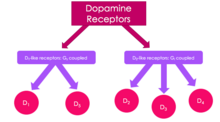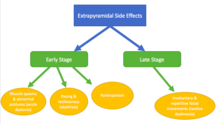| Dopamine receptor antagonist Dopaminergic blockers | |
|---|---|
| Drug class | |
 Skeletal structural formula of Haloperidol, a typical antipsychotic Skeletal structural formula of Haloperidol, a typical antipsychotic | |
| Class identifiers | |
| Use | Schizophrenia, bipolar disorder, nausea and vomiting, etc. |
| ATC code | N05A |
| Biological target | Dopamine receptors |
| External links | |
| MeSH | D012559 |
| Legal status | |
| In Wikidata | |
A dopamine antagonist, also known as an anti-dopaminergic and a dopamine receptor antagonist (DRA), is a type of drug which blocks dopamine receptors by receptor antagonism. Most antipsychotics are dopamine antagonists, and as such they have found use in treating schizophrenia, bipolar disorder, and stimulant psychosis. Several other dopamine antagonists are antiemetics used in the treatment of nausea and vomiting.
Receptor pharmacology

Dopamine receptors are all G protein–coupled receptors, and are divided into two classes based on which G-protein they are coupled to. The D1-like class of dopamine receptors is coupled to Gαs/olf and stimulates adenylate cyclase production, whereas the D2-like class is coupled to Gαi/o and thus inhibits adenylate cyclase production.
D1-like receptors: D1 and D5
D1-like receptors – D1 and D5 are always found post-synaptically. The genes coding these receptors lack introns, so there are no splice variants.
D1 receptors
- D1 receptors are found mainly on neurons in the nucleus accumbens as well as substantia nigra, striatum, amygdala, frontal cortex and olfactory bulb and retina
- Also found (in lower levels) in the hypothalamus, thalamus, cerebellum and hippocampus
- Peripherally, these receptors have been found in the renal artery, mesenteric artery, and splenic artery where activation leads to vasodilation. In addition, D1 receptors have been found in the kidney
D5 receptors
- Low levels of D5 receptors have been found in the hypothalamus, prefrontal cortex and cingulate cortex; as well as memory areas such as hippocampus, dentate gyrus and entorhinal cortex.
- In addition, D5 receptors have been found in the kidney
D2-like receptors: D2, D3 and D4
D2-like receptors unlike the D1-like class, these receptors are found pre and post-synaptically. The genes that code these receptors have introns, leading to many alternately spliced variants.
D2 receptors
- D2 receptors are found in the striatum, substantia nigra, ventral tegmental area, hypothalamus, cortex, septum, amygdala, hippocampus, and olfactory tubercle.
- These receptors have also been found in the retina and pituitary gland.
- Peripherally, these receptors have been found in the renal, mesenteric, and splenic arteries as well as on the adrenal cortex and medulla and within the kidney.
D3 receptors
- D3 receptors are highly expressed on neurons in islands of Calleja and nucleus accumbens shell and lowly expressed in areas such as the substantia nigra pars compacta, hippocampus, septal area, and ventral tegmental area.
- Additional studies have found these receptors peripherally in the kidney
D4 receptors
- D4 receptors are found in amygdala, hippocampus, hypothalamus, globus pallidus, substantia nigra pars reticula, the thalamus, the retina and the kidney
Implications in disease
The dopaminergic system has been implicated in a variety of disorders. Parkinson's disease results from loss of dopaminergic neurons in the striatum. Furthermore, most effective antipsychotics block D2 receptors, suggesting a role for dopamine in schizophrenia. Additional studies hypothesize dopamine dysregulation is involved in Huntington's disease, ADHD, Tourette's syndrome, major depression, manic depression, addiction, hypertension and kidney dysfunction. Dopamine receptor antagonists are used for some diseases such as schizophrenia, bipolar disorder, nausea and vomiting.
- Melatonin suppresses dopamine activity as part of normal circadian rhythm functions, although pathological imbalances have been implicated in Parkinson's disease
Side effects
They may include one or more of the following and last indefinitely even after cessation of the dopamine antagonist, especially after long-term or high-dosage use:
- Cardiovascular disease

- Extrapyramidal symptoms (EPS) associated with typical antipsychotics:
- Early stage – occurs at onset of treatment or following increased dose, patients recover when dose is decreased
- Acute dystonias – muscle spasms and sustained abnormal postures and onset occurs within a few days; can be treated with anticholinergics
- risk factors include age, gender and family history
- Akathisia - pacing and restlessness and onset occurs within the first few months; can be treated with beta blockers and benzodiazepines
- Parkinsonism due to effects on the nigrostriatal pathway - includes tremors, bradykinesia and muscle rigidity
- risk factors include age and gender
- Acute dystonias – muscle spasms and sustained abnormal postures and onset occurs within a few days; can be treated with anticholinergics
- Late stage – occurs after prolonged (months-years) treatment, symptoms persist even after dose is decreased
- Tardive dyskinesia - includes involuntary and repetitive facial movements
- risk factors include age, race and gender
- Tardive dyskinesia - includes involuntary and repetitive facial movements
- It is hypothesized that these effects are due to chronic blockade of the D2 receptor
- Early stage – occurs at onset of treatment or following increased dose, patients recover when dose is decreased
- Hyperprolactinaemia due to blockade of the D2 receptors in the anterior pituitary leading to increased prolactin release
- Increased appetite including increased craving and binge eating that lead to weight gain
- Increased risk for insulin resistance
- Sexual dysfunction
- Metabolic changes with increased risk of obesity and diabetes mellitus type 2
- Sedation
- Neuroleptic Malignant Syndrome is a medical emergency caused by a decrease in dopaminergic activity, resulting in a central D2 receptor blockade.
Examples
First-generation antipsychotics (typical)
First generation antipsychotics are used to treat schizophrenia and are often accompanied by extrapyramidal side effects. They inhibit dopaminergic neurotransmission in the brain by blocking about 72% of the D2 dopamine receptors. They can also block noradrenergic, cholinergic, and histaminergic activity.
- Benperidol binds D2 and some serotonin receptors. It is absorbed very easily and has a high first pass effect.
- Chlorpromazine binds D3 with the highest affinity, but also binds D1, D2, D4 and D5

- Clopenthixol
- Droperidol is used as an antipsychotic and antiemetic.
- Haloperidol binds D2, D3 and D4 with the highest affinity, but also binds D1 and D5. Haloperidol also has a risk for QTc prolongation.
- Fluphenazine binds D2 and D3 with the highest affinity but D1 and D5 as well
- Flupentixol binds D1, D2, D3, and D5 and is also used as an antidepressant.
- Fluspirilene
- Penfluridol
- Perazine
- Perphenazine
- Pimozide binds D2 and D3 with high affinity, also binds D4 receptors
- Spiperone binds D2, D3 and D4 with high affinity; can also bind D1
- Sulpiride binds D2 and D3 and is also used as an antidepressant.
- Thioridazine binds D2, D3 and D4 with high affinity; can also bind D1 and D5 at higher concentrations Thioridazine has the highest associated risk of QTc prolongation among neuroleptics.
Second-generation antipsychotics (atypical)
These drugs are not only dopamine antagonists at the receptor specified, but also act on serotonin receptor 5HT2A. These drugs have fewer extrapyramidal side effects and are less likely to affect prolactin levels when compared to typical antipsychotics.
- Amisulpride binds D2 and D3 and is used as an antipsychotic, antidepressant and also treats bipolar disorder. It treats both the positive and negative symptoms of schizophrenia.
- Asenapine binds D2, D3 and D4 and is used to treat bipolar disorder and schizophrenia. Its side effects include weight gain but there is lower risk for orthostatic hypotension and hyperprolactinemia.
- Aripiprazole binds D2 as a partial agonist but antagonizes D3. In addition, aripiprazole treats schizophrenia, bipolar disorder (mania), depression, and tic disorders

- Clozapine binds D1 and D4 with the highest affinity but still binds D2 and D3. Clozapine is unique because it is only prescribed when treatment with at least two other antipsychotics has failed due to its very harsh side effects. It also requires weekly white blood cell counts to monitor potential neutropenia.
- Loxapine binds D2, D3 and D4 with high affinity; can also bind D1. Loxapine is often used to treat agitated and violent patients with neuropsychiatric disorders such as bipolar disorder and schizophrenia.
- Nemonapride binds D3, D4 and D5.
- Olanzapine binds all receptors and is used to treat the positive and negative symptoms of schizophrenia as well as bipolar disorder and depression. It has been associated with significant weight gain.
- Quetiapine binds D1, D2 and D3 and can bind D4 at high concentrations. It is used to treat the positive symptoms of schizophrenia, bipolar disorder and depression. Of the second generation antipsychotics, quetiapine may produce fewer parkinsonian side effects.
- Paliperidone binds D2, D3 and D4 with high affinity; can also bind D1 and D5.
- Remoxipride binds D2 receptors with relatively low affinity.
- Risperidone binds D2, D3 and D4 receptors. Risperidone not only treats the positive and negative symptoms of schizophrenia but also treats bipolar disorder.
- Tiapride blocks D2 and D3 and is used as an antipsychotic. It is also often used to treat dyskinesias, psychomotor agitations, tics, Huntington's chorea and alcohol dependence.
- Ziprasidone blocks the D2 receptor and is used to treat schizophrenia, depression and bipolar disorder. There is controversy on whether Ziprasidone treats negative symptoms and it has well documented gastrointestinal side effects. Ziprasidone can also cause QTc prolongation.
Dopamine antagonists used to treat nausea and vomiting
- Domperidone is a peripherally selective dopamine D2 receptor antagonist used as an antiemetic, gastroprokinetic agent and galactagogue.
- Bromopride binds enteric D2 receptors and also treats gastroparesis.
- Metoclopramide also treats gastroparesis
Antagonists used only in research settings
- Eticlopride binds D2 and D3 with high affinity but also binds D4
- Nafadotride binds D2 and D3
- Raclopride binds D2 and D3 and can be radiolabeled and used in PET imaging to identify disease progression in Huntington's Disease
Other dopamine antagonists
- Mesdopetam is under development for levodopa-induced dyskinesia and psychosis in people with Parkinson's disease
References
- ^ Beaulieu JM, Gainetdinov RR (March 2011). "The physiology, signaling, and pharmacology of dopamine receptors". Pharmacological Reviews. 63 (1): 182–217. doi:10.1124/pr.110.002642. PMID 21303898. S2CID 2545878.
- ^ Sokoloff P, Diaz J, Le Foll B, Guillin O, Leriche L, Bezard E, Gross C (February 2006). "The dopamine D3 receptor: a therapeutic target for the treatment of neuropsychiatric disorders". CNS & Neurological Disorders Drug Targets. 5 (1): 25–43. doi:10.2174/187152706784111551. PMID 16613552.
- ^ Missale C, Nash SR, Robinson SW, Jaber M, Caron MG (January 1998). "Dopamine receptors: from structure to function". Physiological Reviews. 78 (1): 189–225. doi:10.1152/physrev.1998.78.1.189. PMID 9457173.
- Seeman P (August 2006). "Targeting the dopamine D2 receptor in schizophrenia". Expert Opinion on Therapeutic Targets. 10 (4): 515–31. doi:10.1517/14728222.10.4.515. PMID 16848689. S2CID 30902536.
- Iversen SD, Iversen LL (May 2007). "Dopamine: 50 years in perspective". Trends in Neurosciences. 30 (5): 188–93. doi:10.1016/j.tins.2007.03.002. PMID 17368565. S2CID 22686973.
- Zisapel N (December 2001). "Melatonin-dopamine interactions: from basic neurochemistry to a clinical setting". Cellular and Molecular Neurobiology. 21 (6): 605–16. doi:10.1023/A:1015187601628. PMID 12043836. S2CID 25508148.
- Willis GL (2008). "Parkinson's disease as a neuroendocrine disorder of circadian function: dopamine-melatonin imbalance and the visual system in the genesis and progression of the degenerative process". Reviews in the Neurosciences. 19 (4–5): 245–316. doi:10.1515/revneuro.2008.19.4-5.245. PMID 19145986. S2CID 29375454.
- ^ Young SL, Taylor M, Lawrie SM (April 2015). ""First do no harm." A systematic review of the prevalence and management of antipsychotic adverse effects". Journal of Psychopharmacology. 29 (4): 353–62. doi:10.1177/0269881114562090. PMID 25516373. S2CID 8345032.
- ^ Arana GW (2000). "An overview of side effects caused by typical antipsychotics". The Journal of Clinical Psychiatry. 61 (Suppl 8): 5–11, discussion 12–3. PMID 10811237.
- ^ Divac N, Prostran M, Jakovcevski I, Cerovac N (2014). "Second-generation antipsychotics and extrapyramidal adverse effects". BioMed Research International. 2014: 656370. doi:10.1155/2014/656370. PMC 4065707. PMID 24995318.
- ^ Nadal R (2001). "Pharmacology of the atypical antipsychotic remoxipride, a dopamine D2 receptor antagonist". CNS Drug Reviews. 7 (3): 265–82. doi:10.1111/j.1527-3458.2001.tb00199.x. PMC 6741677. PMID 11607043.
- ^ Deng C (September 2013). "Effects of antipsychotic medications on appetite, weight, and insulin resistance". Endocrinology and Metabolism Clinics of North America. 42 (3): 545–63. doi:10.1016/j.ecl.2013.05.006. PMID 24011886.
- ^ Mortimer AM (March 2004). "How do we choose between atypical antipsychotics? The advantages of amisulpride". The International Journal of Neuropsychopharmacology. 7 Suppl 1 (5): S21-5. doi:10.1017/S1461145704004134. PMID 14972081.
- ^ Berman, Brian (January 2011). "Neuroleptic Malignant Syndrome". The Neuro Hospitalists. 1 (1): 41–47. doi:10.1177/1941875210386491. PMC 3726098. PMID 23983836.
- ^ Chokhawala, Krutika (2 October 2021). "Antipsychotic Medications". StatPearls. PMID 30137788 – via NCBI.
- ^ Leucht S, Hartung B (April 2005). "Benperidol for schizophrenia". The Cochrane Database of Systematic Reviews. 2005 (2): CD003083. doi:10.1002/14651858.CD003083.pub2. PMC 7017029. PMID 15846648.
- ^ Beach, Scott (2013). "QTc prolongation, torsades de pointes, and psychotropic medications". The Academy of Psychosomatic Medicine. 54 (1): 1–13. doi:10.1016/j.psym.2012.11.001. PMID 23295003.
- Stoner SC, Pace HA (May 2012). "Asenapine: a clinical review of a second-generation antipsychotic". Clinical Therapeutics. 34 (5): 1023–40. doi:10.1016/j.clinthera.2012.03.002. PMID 22494521.
- Scheidemantel T, Korobkova I, Rej S, Sajatovic M (2015-12-04). "Asenapine for bipolar disorder". Neuropsychiatric Disease and Treatment. 11: 3007–17. doi:10.2147/NDT.S78043. PMC 4675633. PMID 26674884.
- ^ Yang CS, Huang H, Zhang LL, Zhu CR, Guo Q (July 2015). "Aripiprazole for the treatment of tic disorders in children: a systematic review and meta-analysis". BMC Psychiatry. 15: 179. doi:10.1186/s12888-015-0504-z. PMC 4518630. PMID 26220447.
- Brown R, Taylor MJ, Geddes J (December 2013). "Aripiprazole alone or in combination for acute mania" (PDF). The Cochrane Database of Systematic Reviews (12): CD005000. doi:10.1002/14651858.CD005000.pub2. PMC 11330668. PMID 24346956.
- Popovic D, Nuss P, Vieta E (2015-04-01). "Revisiting loxapine: a systematic review". Annals of General Psychiatry. 14: 15. doi:10.1186/s12991-015-0053-3. PMC 4391595. PMID 25859275.
- Pollack CV (July 2016). "Inhaled loxapine for the urgent treatment of acute agitation associated with schizophrenia or bipolar disorder". Current Medical Research and Opinion. 32 (7): 1253–60. doi:10.1185/03007995.2016.1170004. PMID 27121764. S2CID 4402288.
- Asmal, Laila (2013). "Quetiapine versus other atypical antipsychotics for schizophrenia". Cochrane Database of Systematic Reviews (11): CD006625. doi:10.1002/14651858.CD006625.pub3. PMID 24249315.
- ^ Corena-McLeod M (June 2015). "Comparative Pharmacology of Risperidone and Paliperidone". Drugs in R&D. 15 (2): 163–74. doi:10.1007/s40268-015-0092-x. PMC 4488186. PMID 25943458.
- Dose M, Lange HW (January 2000). "The benzamide tiapride: treatment of extrapyramidal motor and other clinical syndromes". Pharmacopsychiatry. 33 (1): 19–27. doi:10.1055/s-2000-7964. PMID 10721880. S2CID 260238868.
- Stahl SM, Shayegan DK (2003). "The psychopharmacology of ziprasidone: receptor-binding properties and real-world psychiatric practice". The Journal of Clinical Psychiatry. 64 (Suppl 19): 6–12. PMID 14728084.
- Tonini M, Cipollina L, Poluzzi E, Crema F, Corazza GR, De Ponti F (February 2004). "Review article: clinical implications of enteric and central D2 receptor blockade by antidopaminergic gastrointestinal prokinetics". Alimentary Pharmacology & Therapeutics. 19 (4): 379–90. doi:10.1111/j.1365-2036.2004.01867.x. PMID 14871277.
- Martelle JL, Nader MA (2008). "A review of the discovery, pharmacological characterization, and behavioral effects of the dopamine D2-like receptor antagonist eticlopride". CNS Neuroscience & Therapeutics. 14 (3): 248–62. doi:10.1111/j.1755-5949.2008.00047.x. PMC 2753830. PMID 18801115.
- Pagano G, Niccolini F, Politis M (June 2016). "Current status of PET imaging in Huntington's disease". European Journal of Nuclear Medicine and Molecular Imaging. 43 (6): 1171–82. doi:10.1007/s00259-016-3324-6. PMC 4844650. PMID 26899245.
- "Mesdopetam - Integrative Research Laboratories". AdisInsight. 6 September 2024. Retrieved 25 September 2024.
- Alsalmi M, Al-Kassmy J, Kang W, Palayew M, Huot P (2024). "Levodopa-induced dyskinesia: do current clinical trials hold hope for future treatment?". Expert Opin Pharmacother. 25 (1): 1–3. doi:10.1080/14656566.2023.2298345. PMID 38116733.
- Kiss B, Laszlovszky I, Krámos B, Visegrády A, Bobok A, Lévay G, Lendvai B, Román V (January 2021). "Neuronal Dopamine D3 Receptors: Translational Implications for Preclinical Research and CNS Disorders". Biomolecules. 11 (1): 104. doi:10.3390/biom11010104. PMC 7830622. PMID 33466844.
External links
- Dopamine+antagonists at the U.S. National Library of Medicine Medical Subject Headings (MeSH)
| Pharmacomodulation | |||||||||||||||||||||||||||||||||
|---|---|---|---|---|---|---|---|---|---|---|---|---|---|---|---|---|---|---|---|---|---|---|---|---|---|---|---|---|---|---|---|---|---|
| Types |
| ||||||||||||||||||||||||||||||||
| Classes |
| ||||||||||||||||||||||||||||||||
| Drugs for functional gastrointestinal disorders (A03) | |||||||||||||
|---|---|---|---|---|---|---|---|---|---|---|---|---|---|
| Drugs for functional bowel disorders |
| ||||||||||||
| Belladonna and derivatives (antimuscarinics) |
| ||||||||||||
| Propulsives | |||||||||||||